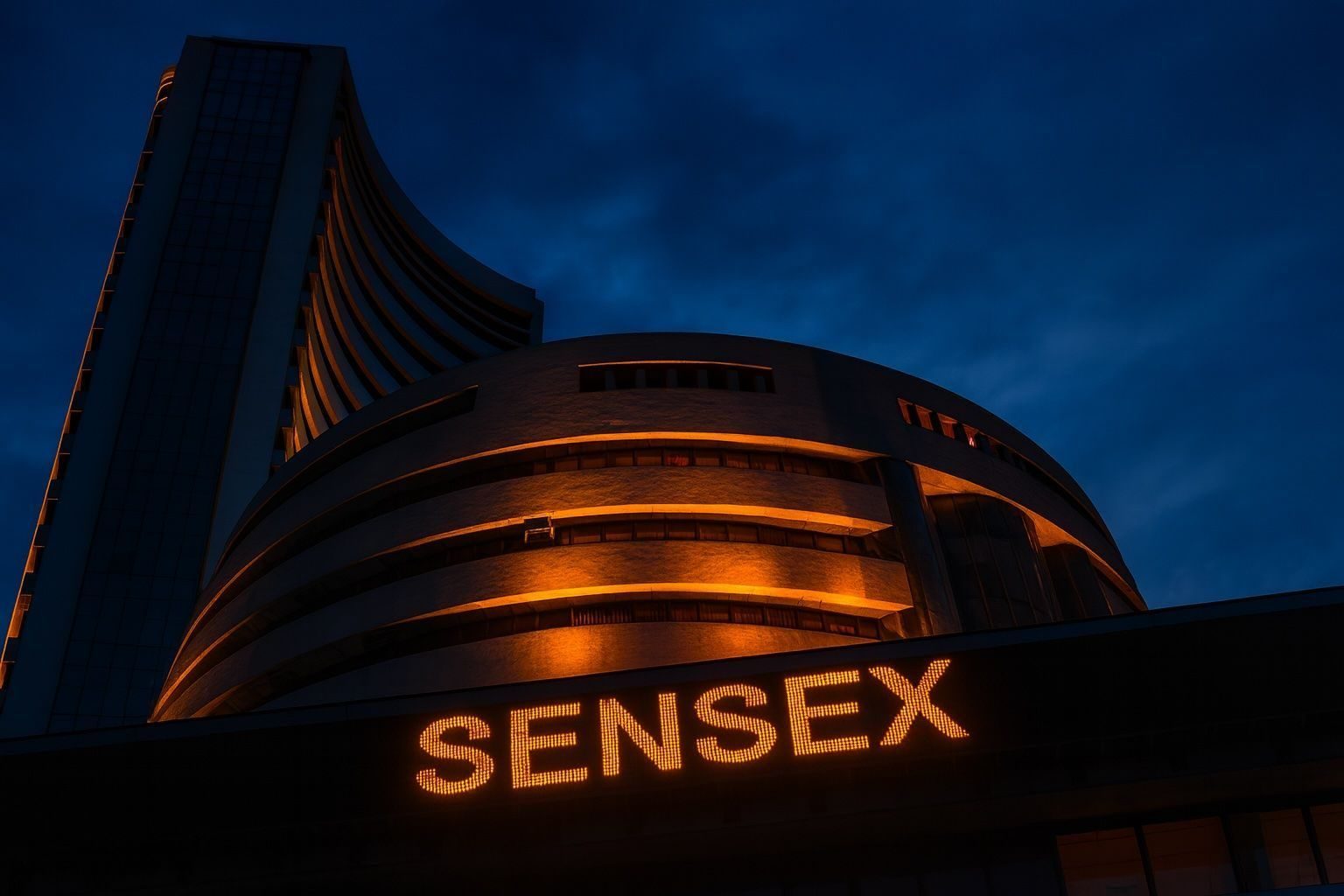Mumbai, November 27, 2025 – Indian equities extended their record‑breaking run on Thursday, with the Sensex and Nifty 50 hitting fresh lifetime highs before profit‑taking pulled the benchmarks back to a largely flat close. Gains in banking, financials, autos and media offset weakness in IT and oil & gas, while the rupee stayed pinned near historic lows against the US dollar.
Indian stock market today: key closing levels
India’s headline indices managed to end in the green, but only just, after an intraday surge triggered by rate‑cut optimism and renewed institutional buying.
- The S&P BSE Sensex rose 110.87 points (0.13%) to close at 85,720.38, after briefly scaling a new all‑time high of 86,055.86. [1]
- The NSE Nifty 50 added 10.25 points (0.04%) to settle at 26,215.55, having earlier touched a record 26,310.45 – a fresh peak after a 14‑month wait of 289 trading sessions. [2]
Broader markets underperformed:
- The BSE Midcap index finished almost flat.
- The BSE Smallcap index slipped around 0.4%, reflecting continued caution in the high‑beta, valuation‑rich space. [3]
Volatility stayed contained, with the India VIX edging lower, signalling that despite intraday swings – including a 550‑point drop from the Sensex’s high at one stage – traders are treating the move more as consolidation than the start of a reversal. [4]
Sector snapshot: banks, autos and media at new highs
Thursday’s market action was distinctly sector‑driven rather than a broad‑based melt‑up.
Financials and autos led the charge
- Nifty Financial Services, Nifty Bank and Nifty Auto all registered new record highs during the session, underscoring the market’s preference for lending, consumption and rate‑sensitive plays as talk of interest‑rate cuts grows louder. [5]
- On the Sensex, Bajaj Finance, ICICI Bank, Bajaj Finserv, Hindustan Unilever and HCL Technologies were among the top gainers, closing between roughly 0.8% and 2.3% higher. [6]
Media steals the spotlight
- Nifty Media emerged as the top‑gaining sector for the day, with stocks such as TV18 Broadcast and Saregama clocking strong advances as investors rotated into domestic cyclicals and content‑driven plays. [7]
Laggards: IT, oil & gas and select blue chips
- Intraday updates showed IT stocks slipping up to about 2%, while oil & gas names weakened, reflecting profit‑taking after the recent global risk‑on rally. [8]
- On the Nifty 50, Eicher Motors was the worst performer, falling more than 3% from its intraday high. SBI and Maruti Suzuki were also highlighted as major drags during the session. [9]
The overall picture: leadership is narrow and skewed toward large financials and a handful of sectors, even as headline indices log new highs – a pattern that analysts say warrants some caution.
FII–DII flows: domestic money still in the driver’s seat
The latest available data underline a striking divergence between foreign and domestic investors.
- On November 26, Foreign Institutional Investors (FIIs) were net buyers of ₹4,778 crore in the cash market, while Domestic Institutional Investors (DIIs) bought a sizeable ₹6,247 crore, according to provisional exchange numbers. [10]
- For 2025 year‑to‑date, FIIs remain substantial net sellers of Indian equities (over ₹2.5 lakh crore of outflows), whereas DIIs – led by mutual funds, insurers and banks – have collectively net bought around ₹7 lakh crore, effectively backstopping the market. [11]
This heavy domestic participation helps explain why the equity market is near record highs even as foreign money is still cautious and the currency is under sustained pressure.
Rupee today: near record low despite equity euphoria
The currency market told a more fragile story than Dalal Street’s closing print.
- The rupee ended around 89.30 per US dollar, nearly unchanged from the previous close near 89.27, according to interbank data cited by Reuters and other trackers. [12]
- The rupee is hovering just off its all‑time low near 89.5, hit last week, making it Asia’s worst‑performing currency of 2025 and putting it on track for its sharpest annual decline since 2022. [13]
A detailed analysis published on Thursday linked the rupee’s weakness to:
- Steep US tariffs – now around 50% – on many Indian exports,
- Large portfolio outflows from Indian equities over the year, and
- A more selective, “volatility‑focused” intervention stance from the Reserve Bank of India (RBI), which has reportedly sold over $30 billion of FX reserves since July. [14]
Finimize noted that while the rupee is pinned near record lows, Sensex and Nifty 50 are at record highs, underlining a “split‑screen” market where domestic flows and earnings support equities even as external accounts and trade tensions weigh on the currency. [15]
Why Dalal Street is rallying: rates, earnings and macro signals
Thursday’s session did not happen in isolation. A cluster of macro and policy expectations is feeding into the risk‑on mood in Indian equities:
- Rate‑cut expectations from RBI
- A Reuters poll of economists published today shows a majority expecting the RBI to cut its key policy rate by 25 bps to 5.25% at the December 3–5 policy meeting, after consumer inflation dropped to just 0.25% in October. [16]
- RBI officials have also recently signalled that there is “room” for further easing, even as they emphasise data‑dependence and financial‑stability risks. [17]
- Resilient growth backdrop
- The Finance Ministry’s latest monthly economic review pegs Q2 FY26 real GDP growth in the 7–7.5% range, pointing to robust domestic demand, easing price pressures and continued government capex. [18]
- Independent research from banks and think‑tanks also expects Friday’s official Q2 GDP print (due November 28) to come in at or above 7%, despite tariff‑related headwinds. [19]
- Domestic demand and earnings momentum
- High‑frequency data – including a manufacturing PMI above 59 and industrial production growth around 4% in September – continue to signal strong post‑festive demand, particularly in consumption and manufacturing. [20]
- Analysts quoted across brokerages highlight expectations of double‑digit earnings growth into FY27, especially in financials, autos, infrastructure and select consumer names. [21]
- Trade and geopolitics: risk and opportunity
- India remains locked in negotiations over a US–India trade framework, after Washington sharply raised tariffs in response to India’s past purchases of Russian oil. The higher tariff regime has contributed both to rupee pressure and to earlier foreign equity outflows. [22]
- At the same time, Commerce Minister Piyush Goyal has suggested that a US trade deal is “close”, while India is simultaneously pushing free‑trade agreements with multiple partners, including Oman and other Gulf economies – a potential medium‑term positive for export‑oriented sectors if deals materialise. [23]
Put together, the market is essentially betting that low inflation + decent growth + eventual rate cuts + progress on trade can offset near‑term currency stress and global uncertainties.
Global cues: Fed cut bets and a quiet Wall Street
Global risk sentiment stayed constructive, though US markets were shut for the Thanksgiving holiday.
- Across Asia, equities largely traded higher on Thursday, supported by rising expectations that the US Federal Reserve will cut rates in December after a run of softer economic data. An MSCI Asia‑Pacific index gained around 0.4%, with Japan’s Nikkei up over 1%. [24]
- European shares were muted to slightly lower, pausing after a three‑day rally, with the pan‑European STOXX 600 hovering near one‑week highs as investors consolidated gains. [25]
- Wall Street is closed today for Thanksgiving and will reopen on Friday for a shortened session, after major US indices logged a fourth straight day of gains on Wednesday on the back of a tech‑led rally and Fed‑cut optimism. [26]
The global backdrop therefore remains broadly supportive for risk assets like Indian equities, though the absence of US trading volumes may have accentuated intraday swings on Dalal Street.
IPO pipeline and stock‑specific action
Beyond the indices, investors are positioning for a busy primary and secondary deal calendar.
- Brokerage analysis projects that December 2025 IPOs could raise ₹35,000–₹40,000 crore, with consumer‑tech names like Meesho and electronics brand boAt among the most closely watched candidates, adding to an already strong year for primary fundraising. [27]
- On Thursday’s trade, the Economic Times live blog highlighted:
- A sharp 13% drop in Whirlpool of India after reports of a large promoter stake sale via a block deal,
- A planned ₹670‑crore IPO by Aequs in early December, and
- Continued stock‑specific volatility in names that had run up sharply in prior months. [28]
Such activity suggests that while frontline indices are making incremental highs, stock selection remains crucial, with pockets of both exuberance and stress co‑existing beneath the surface.
Expert view: record highs, narrow breadth and “FOMO” risk
Market strategists broadly agree that the medium‑term story for India remains constructive, but they urge restraint after the latest breakout.
Key messages from Thursday’s commentary:
- Analysts at Moneycontrol and other brokerages emphasised that while the undertone is positive, the near‑term upside from current levels may be “measured”, limited to a few percentage points unless earnings upgrades broaden out. [29]
- Several experts cautioned against “FOMO buying” – chasing momentum purely because indices are at all‑time highs – noting that a large chunk of the mid‑ and small‑cap universe is still in a corrective or fragile zone. [30]
- Technically, many strategists now see the 26,300–26,500 zone on Nifty 50 as an important resistance band in the short term, with support around 25,800–26,000. As long as the index holds above these supports, they expect a “buy‑on‑dips” bias to persist, albeit with higher volatility. [31]
- Economic Times commentary also flagged that markets are entering a phase where tomorrow’s Q2 GDP print, progress on the US–India deal and the December RBI policy could significantly influence the next leg of the trend. [32]
In short, the consensus is that India’s structural story remains intact, but the rally is increasingly selective and policy‑sensitive.
What it means for investors
For investors, today’s session on Dalal Street reinforces a few themes:
- Headline indices can keep notching new highs even when breadth is narrow and the currency is weak.
- Domestic flows, macro resilience and rate‑cut hopes are doing heavy lifting at a time when foreign investors are still cautious.
- Policy events over the next few weeks – GDP data, the RBI meeting and any visible movement on a US–India trade deal – are likely to determine whether this breakout evolves into a sustained uptrend or shifts into a consolidation phase.
As always, these developments are informational, not a guarantee of future performance. Market risk remains elevated at record levels, and any strategy should be aligned with individual risk tolerance and horizon.
References
1. m.economictimes.com, 2. m.economictimes.com, 3. www.livemint.com, 4. m.economictimes.com, 5. www.ndtvprofit.com, 6. m.economictimes.com, 7. www.ndtvprofit.com, 8. m.economictimes.com, 9. www.ndtvprofit.com, 10. www.moneycontrol.com, 11. www.moneycontrol.com, 12. www.marketscreener.com, 13. finimize.com, 14. www.reuters.com, 15. finimize.com, 16. www.reuters.com, 17. www.reuters.com, 18. www.uniindia.com, 19. m.economictimes.com, 20. m.economictimes.com, 21. www.moneycontrol.com, 22. www.washingtonpost.com, 23. www.niftytrader.in, 24. www.reuters.com, 25. www.reuters.com, 26. www.investopedia.com, 27. www.samco.in, 28. m.economictimes.com, 29. www.moneycontrol.com, 30. www.moneycontrol.com, 31. www.moneycontrol.com, 32. m.economictimes.com







